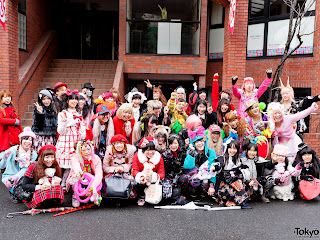To understand my audience fully I need to identify a
certain target for my game. I have specifically chosen to base my game on a
non-violent topic which would make my game fun for all ages, but I understand
that this style would not suite everyone’s taste, which is why I am aiming it
primarily at people in the Western culture which are interested in modern Japanese
culture. By aiming it at this group of people I allow them to explore a magical
world, which is separate from their personal home lives. If I aimed my game at
Aisain countries I feel that the novelty and owe may not be the same, however
they would still enjoy the game itself and enjoy playing it. In this post I
will be looking at ‘Kawaii’ Japanese fashion culture and how to incorporate
this into my game. Kawaii is the Japanese word for ‘cute’, but the word is
often used when describing a particular aesthetic style rather than a general
statement. Kawaii style usually consists of obsessive decoration, kitsch,
animals and food with large eyes and a cat mouth, bright colours and often very
girly. Below are examples of Japanese clothing culture, of both Harajuku and
Lolita clothing, which will explain further what the trends and norm in Japan is,
meaning that my game needs to fit into this normality.
Harajuku girls originate from the area in Tokyo, Harajuku, and usually congregate by the tube platforms. Over the last decade, visiting the ‘Harajuku girls’ has been one of Japan’s largest tourist attractions, and many of the independent clothing stores in that area have flourished in selling alternative clothes.
Here is the Lolita style of clothing, which is similar to Harajuku style, but in my opinion is more a popular clothing choice in the Western countries as it is more gothic. Rather than using the bright and daring colours, which the girls of Harajuku are unafraid to use, Lolita girls tend to wear pastel colours with monochrome, but still accessorize but not as much!
Both Lolita and Harajuku styles are mainly female
driven, but this doesn’t mean that males aren’t following these fashions too,
it is just more readily available for women. These are also not the only
fashion styles available in Japan, but these are the two I am most interested
in as they are easily identifiable.
Gwen Stefani is one of the biggest ambassadors of
Japanese culture in Western culture, making the culture and lifestyle more
accessible for those not living in Japan. This also shows me that my game will
have an audience in these areas of the world too as Gwen and the band No Doubt
is so popular. She has always shown an interest in Asian culture, choosing to
wear a bindi whilst in No Doubt, and then choosing to have Harajuku girls as
backing dancers during her solo tour. This influence is seen in the music
itself, but also the music videos, her clothing, her image and everything
surrounding her brand.
As my game concept, and my drawing/artistic style is
very stylized and child-like, I feel that my game would attract young children,
even when they are not my main target audience. I feel my game could attract a
wide age group, as it is open and joyful, and not restrained to an older age
group due to the content. I took some time trying to find images of younger
Japanese children, which choose to dress in the bolder Japanese clothing
styles, and found that it is quite common for older children and teenagers, to
choose to do this. Whereas in Europe or America this form of self-expression,
especially with this sort of clothing, would usually be rare as often children
are bullied for what they wear. In my game I am aiming to promote players to
embrace their own style and not to be afraid of people judging you; the
characters used will mainly do this, but the environment will obviously embrace
this ideal too.















No comments:
Post a Comment